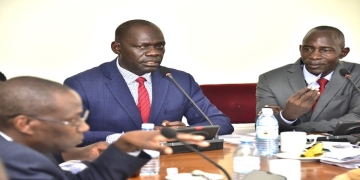The present system of education, known as Universal Primary Education (UPE), has existed since 1997, and its introduction was the result of democratisation and open elections, as there was great popular support for free education.
Despite its promising boosts in enrolment, issues with funding and organisation have continued to plague the Universal Primary Education
In 1999 there were six million pupils receiving primary education, compared to only two million in 1986. Numbers received a boost in 1997 when free primary education was made available to four children per family.
Only some of primary school graduates go on to take any form of secondary education.
This is contingent upon their passing their Primary Leaving Examinations (PLE).

Uganda is one of East Africa’s developing countries, bordered by Tanzania, Rwanda, the Democratic Republic of the Congo, South Sudan, and Kenya.
It occupies 236,040 square kilometres (91,140 sq mi) and has 26,404,543 people.
According to CIA World Fact Book 2004, more than 80 percent of its population is rural and 35% of the people lives below poverty line.
The United Nations characterised the current condition of Uganda with its unstable government and struggling people as “the world’s worst humanitarian crisis.”
In 1997 the Ugandan government introduced the Universal Primary Education (UPE) program to improve enrollment and attainment in primary schools. It was initially realized to provide free education for four children per family, but the program was not performing based in its regulations due to the complex structure of Ugandan families.
Most Ugandan families have more than four children and households started sending every child, which resulted in a rapid increase in student enrollment in primary schools.
Due to the circumstances, President Museveni announced that the Universal Primary Education was open to all children of all families (Omona 74).
When the new policy was executed, schools experienced a massive influx of pupils and the demand for learning materials, teachers, and infrastructure became a challenge to the education system.
Ngaka argues that the University Primary Education resulted in costly consequences, including but not limited to a poor quality education, low pupil achievement, untrained teachers, improper infrastructures and classroom settings.
The Human Rights Measurement Initiative gives Uganda a score of 92.3% for primary school enrolment.
Uganda has seven years of primary education and the legal age for school entry is six.
According to the Ministry of Education and Sports (MoES) statistics, school enrollments increased from three million to 5.3 million in 1997 and the number rapidly increased to seven million by 2004.
Even though the increased number of pupils was perceived as a good thing, there were only 125,883 teachers, exceeding the Universal Primary Education required pupil-teacher ratio of 1:40.
The large number of pupils worsens the learning environment and it becomes harder for the teacher to be heard and teach. According to Arbeiter and Hartley, classes have between 70 and 150 pupils and there is over-age studying in all schools.
Moyi explains the issue of many classes having the inappropriate age of pupils as having been driven by late enrolment or grade repetition, which in turn is caused by the poor quality of education.
For instance, “third grade included pupils aged between seven to sixteen years and in sixth grade there were pupils up to nineteen years of age.”










Discussion about this post